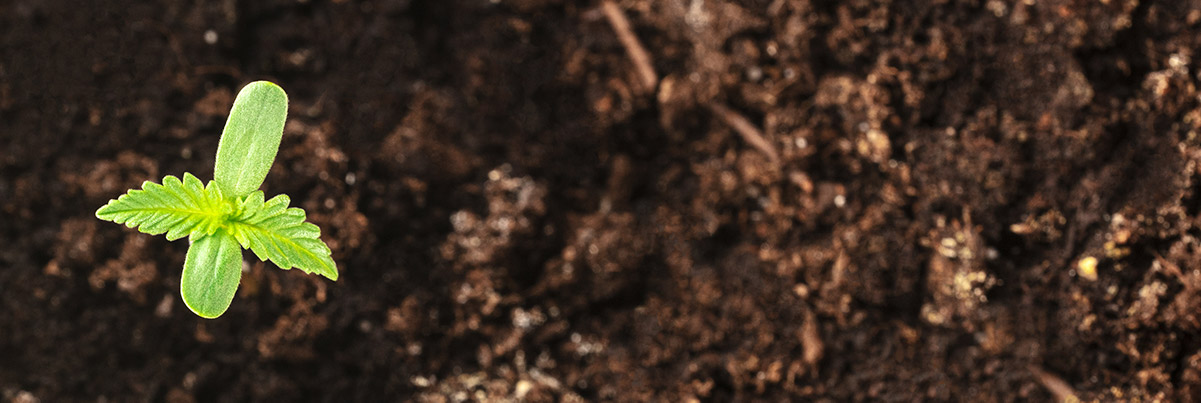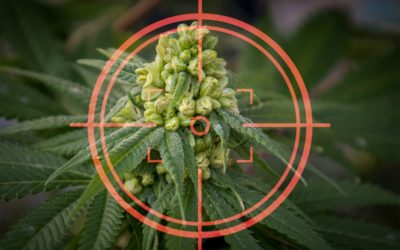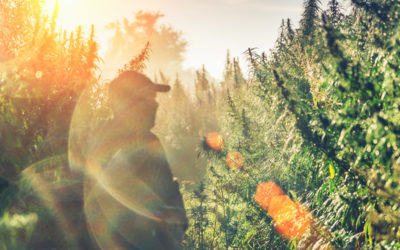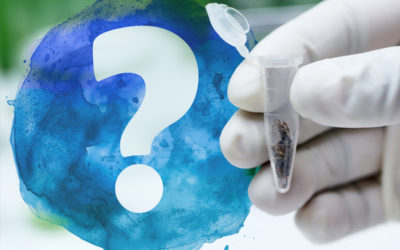Methods and techniques for growing CBD hemp arise from basement “grow laboratories” in the high-THC cannabis industry. But that knowledge must be adapted to the legal, industrial U.S. hemp crop with its significantly scaled-up footprint nationwide since the passage of the 2018 Farm Bill.
Good research, planning and preparation help hemp farmers compete with peers who have evolved workable ag-scale models for the transition into growing USDA compliant hemp. It all starts, of course, with legal CBD hemp seeds.
Combine the right conditions for hemp seed germination
When it comes to growing hemp from seed, the good news is that it’s similar to many other crops that farmers are familiar with planting in the spring. Hemp thrives in the same kind of soil that a common home vegetable garden enjoys: “loose, deep soils rich in organic matter, on fertile loams, and with a pH from 6.0 to 7.5. Hemp does not grow well in wet soils,” according to the Oregon State University Extension. Neither does hemp do well in hard-pack or clayed soils, which can be excessively moist or impenetrably dry.
Despite the general school of thought that hemp can grow anywhere, a pristine crop and even canopy, which make for a smooth, successful harvest when growing for cannabinoid production (CBD, CBG, etc.), are achieved in soil selected and prepared for the specific hemp seed a farmer sows. At this point, you already should be pondering (or have decided) on the question of sowing seeds directly into the field or germinating seeds in a greenhouse — or both. Depending on a hemp farmer’s master plan for the 2020 season, a schedule, timing and infrastructure blueprint will need to be adjusted to allocate resources appropriately for the duration of either method.
Related: Pros and Cons of Directly Sowing Hemp Seeds
While direct sowing of hemp seeds may save on labor and potting soil costs, amending acres upon acres of field and tending to them meticulously through the germination phase may be cost-prohibitive or unrealistic for a crew’s size and a property’s capabilities — or even impossible amid frost or bad weather on either end of the hemp growing season. Remember, germination is the most fragile time in a hemp plant’s life cycle — the time to pay close attention while preparing and maintaining the ideal soil conditions. This can be the deciding factor for initial hemp crop survival.

Many hemp farmers mitigate much of this risk by putting in extra work early to get a head start on the season in varying degrees of climate-controllable greenhouses. From basic hoop houses that afford the minimal barrier against late frosts to fully automated, light-assisted and/or heated, light-deprivation grow compounds that can pull off multiple hemp harvests per year, each farmer can set a customized stage for success.
Greenhouse germination allows for control of other conditions, as well. Pest and disease access are limited and even can be isolated from other batches within a hemp growing facility. Compacting all hemp plants on a farm into a smaller greenhouse footprint also conserves labor and resources allocated to maintaining hemp seedlings during this fragile beginning stage of life.
Another piece in the puzzle for successful hemp seed starts in a greenhouse setting is “store-bought” soil (or an equivalent homemade mixture), coco-coir starter cubes or some other ideal environment with minimal nutrients, good drainage and good water retention as a growing medium. “Hemp seeds require a firm seedbed and good soil contact to germinate well” (2).
Pro tip: Achieve ideal moisture levels and temperature for hemp seedlings. The experts at HumboldtSeeds.net advise: “With moisture: you’re looking for a medium level of dampness, never soaking, (water method not inclusive). Temperature-wise: You’re seeking to provide a range somewhere in the vicinity 23-26C/75-80F”. These ideal settings help ensure that plants do not suffer through potential hazards of exposure to varying spring temperatures and weather conditions.
In reality, whether in a greenhouse or out in the field, the importance of an ideal environment for germination can’t be overstated. It’s important to help hemp plants “establish good roots” before sending those babies into the field to brave harsh conditions and exposure to the elements throughout the growing season.
Plant hemp seeds at the right depth
A simpler question to answer, thanks to years of research, is: “What is the right depth to plant my hemp seeds?” At this point, most hemp seed planting is automated. Hand-planting individual seeds or “broadcasting” seed to sow directly into the field are not ideal methods when growing hemp on a large scale, especially for cannabinoid production.
Many hemp farmers — especially those who plan to begin their season in greenhouses — actually are purchasing trays of hemp seeds pre-planted on an automated setup. These machines are outfitted to accurately plant tens of thousands of seeds in a single run, all in soil mixed especially for hemp seedlings. Settings on these machines can be adjusted for a hemp farmer’s specific needs, including plant counts and planting depth. The Penn State University Extension program suggests a planting depth of 1/2 to 3/4 inch. With the ability to specify one’s requirements and shipping now legal, the options are almost endless for making a hemp farmer’s life easier.
Conversely, for sowing directly into the field, modern technology also is developing on that front. A well-known name in the industry, John Deere, offers machinery and programming that allows settings to be dialed in “for a particular crop, condition or management practice. With just one button, you can set rates, downforce, row cleaners, alarm preferences as well as tractor settings” (5). Farming continues its technological advancement, exponentially growing in both scale and efficiency.
Common hemp farming mistakes: Poor planning leads to poor planting
While greenhouses can make a hemp farmer feel invincible against the elements, they present an easy opportunity to get ahead of oneself. Do not put hemp seedlings out too early and risk early frost die-off. On the other hand, crowding a greenhouse because you started too early but can’t move hemp starts into the field also is an avoidable mistake.
While it’s smart to plant extra hemp starts in the greenhouse to fill gaps after initial transplant losses in the field, too many hemp plants can inhibit light penetration, air flow and create watering issues, opening up potential for pests, disease outbreak or simply dried-up root systems. Know your hemp seed stock. Know your planting window. Know your harvest window. Prepare infrastructure and crews to act before those windows arrive.
Perhaps, most importantly: Know your harvesting, drying and curing capabilities — and plant accordingly. Get those services and labor scheduled as far in advance as possible. Having “eyes bigger than your drying building” is a common rookie mistake, leading to wasted biomass or unsafe post-harvest conditions in the scramble to save one’s hemp crop.

When to transplant hemp seedlings
The easy answer to this question is: Transplant into the field when the weather is right and the hemp seedlings are well-established in their pots. But this simple response does not account for all factors that make up a hemp farmer’s season strategy.
Autoflower hemp will fall into this “when it’s time” strategy much easier, as it will mature earlier than full-term hemp and eliminate the issues of planting too soon. Note that with current breeding: Autoflower varieties have a limited range from seeding to harvest of 50-80 days. Essential oil hemp and fiber hemp varieties require 70-120 days from seeding to harvest.
Related: Lightning Autoflower — 75 Days From Germination to Harvest
Planting full-term hemp (commonly grown for essential oil/cannabinoid production) too early — even avoiding the frost on the spring side — may set farmers up for devastation as harvest approaches. Varieties bred for production of cannabinoids like CBD often focus their energy into the flowers and cannot support themselves structurally after reaching a certain size, especially when holding up dense flowers that are potentially soaked in rain.
Choose a planting date that not only prevents the need for propping branches in the weeks before harvest but also factors in the number of hemp plants per acre. This will help to ensure even canopy growth that covers the ground to shade root systems without overcrowding neighboring hemp plants. With full-term plant spacing recommendations ranging from 2 feet to 6 feet and acreage numbers ranging from 2,000 to 3,000 hemp plants per acre, researching the growth patterns of one’s hemp seed stock and comparing this information to local conditions and harvest plans will foster familiarity with unknown factors a hemp farmer can face.
Watering is the final factor to weigh as plants’ root systems and cell structures are maturing. If irrigation methods are not gentle or directed enough to reach the babies a hemp farmer has handed over to the elements, they could be washed away, pummeled by heavy sprinklers or simply dry out within hours of being planted in their new homes.
Hemp has the best odds of thriving when it has been started in an ideal environment that helps to develop good root systems. While it’s not rocket science, planting goals should ensure that hemp seeds enjoy the best beginnings, insulating a farmer’s investment and cultivating the best chances for pulling off a successful hemp harvest.





Hi! Great post. The most reliable way to grow hemp seeds for outdoor production is a greenhouse. It is very easy to regulate temperature, humidity and soil moisture levels, and supplemental lighting can be added to long days in the spring.
Well reasoned especially in emphasizing the planning ahead needed for a successful crop. I will be a first time grower in Virginia and am sitting here staring at my little packet of 100 seeds and wanting to quickly get them into peat pots so they’ll be ready for the field in 50 degree plus weather. One worry now is to completely surround the growing area with 10 foot high netting to keep the deer out. My biggest concern is far apart must I plant them. Thanks for the priceless but cost free information.
We’re glad you found this information helpful! May your plants be healthy and your crop bountiful.